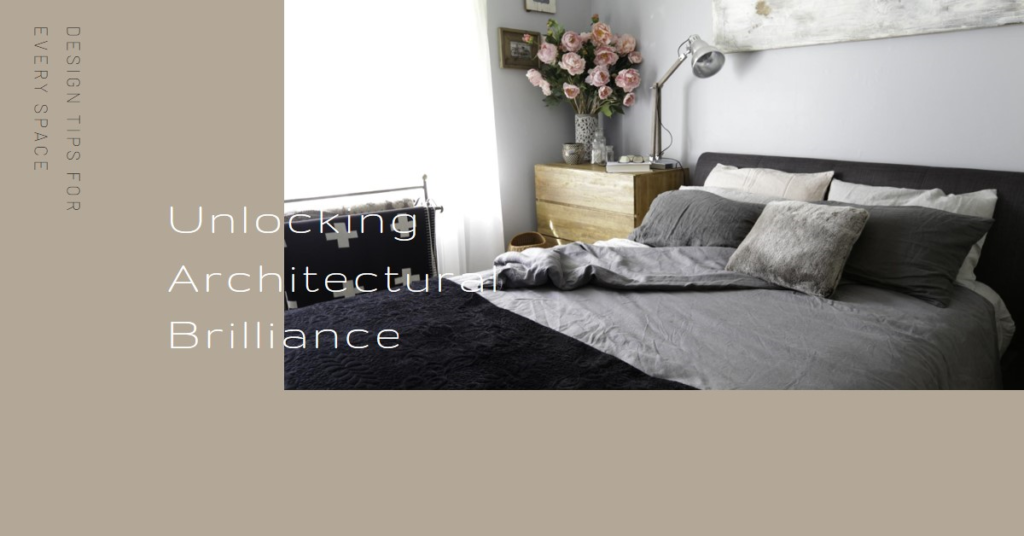
Table of Contents
Introduction – Architect
: Unlocking the full potential of a space through architectural brilliance is an art form that combines creativity, functionality, and innovation. Whether it’s a cozy apartment, a sprawling mansion, or a commercial establishment, every space has the potential to become a masterpiece with the right design approach. In this guide, we delve into a plethora of design tips that can elevate any space from ordinary to extraordinary, creating an environment that is not only visually stunning but also highly functional and conducive to the needs of its occupants.
Maximizing Natural Light:
Illuminating the Space One of the most transformative elements in architectural design is the use of natural light. Harnessing sunlight not only reduces energy consumption but also creates a sense of openness and vitality within a space. To maximize natural light, consider strategic placement of windows, skylights, and glass doors to allow sunlight to flood the interiors. Additionally, opting for light-colored walls and reflective surfaces can further enhance the luminosity of the space, making it feel larger and more inviting.
Embracing Minimalism:
Simplifying the Design In today’s fast-paced world, the concept of minimalism has gained immense popularity for its clean lines, clutter-free spaces, and emphasis on functionality. Embracing minimalism in architectural design involves stripping away unnecessary elements and focusing on essential features that contribute to the overall aesthetics and functionality of the space. By decluttering the interiors and opting for sleek, understated furnishings, you can create a sense of calm and tranquility that promotes clarity of thought and enhances the visual appeal of the space.
Harmonizing Form and Function:
Balancing Practicality with Aesthetics Great architectural design strikes a delicate balance between form and function, ensuring that the space not only looks beautiful but also serves its intended purpose effectively. When designing a space, consider how each element contributes to both the visual appeal and the functionality of the area. Incorporate multi-functional furniture, built-in storage solutions, and versatile layout configurations to optimize the usability of the space without compromising on style.
Creating Seamless Transitions:
Blurring Boundaries Between Indoor and Outdoor Spaces Innovative architectural design blurs the boundaries between indoor and outdoor spaces, creating a seamless transition between the two environments. Incorporating features such as sliding glass doors, outdoor patios, and rooftop gardens allows for a fluid connection with nature, fostering a sense of harmony and tranquility within the space. By integrating outdoor elements into the design, you can maximize the perceived square footage of the space and create an immersive environment that enhances the overall living experience.


Playing with Scale and Proportion:
Adding Visual Interest Scale and proportion are fundamental principles of architectural design that can greatly influence the perception of space. By playing with scale and proportion, designers can create visual interest and evoke emotional responses within a space. Experiment with varying heights, sizes, and shapes of architectural elements to add dynamism and character to the interiors. Whether it’s oversized statement pieces, asymmetrical layouts, or dramatic ceiling heights, thoughtful manipulation of scale and proportion can transform an ordinary space into a captivating work of art.
Infusing Texture and Contrast:
Adding Depth and Dimension Texture and contrast are powerful tools in architectural design that can add depth and dimension to a space, stimulating the senses and creating visual intrigue. Incorporate a variety of textures such as wood, stone, metal, and fabric to add richness and tactile interest to the interiors. Contrast smooth surfaces with rough, matte finishes with glossy, and light tones with dark to create a dynamic interplay of elements that captivates the eye and creates a sense of depth within the space.
Incorporating Sustainable Design Practices:
Building for the Future In an increasingly environmentally conscious world, sustainable design practices have become essential considerations in architectural design. By integrating eco-friendly materials, energy-efficient systems, and passive design strategies, architects can minimize the environmental impact of buildings while creating healthier and more resilient living spaces. From green roofs and rainwater harvesting systems to passive solar design and recycled materials, there are myriad ways to incorporate sustainability into architectural design and build a better future for generations to come.
Personalizing the Space:
Reflecting Individual Tastes and Lifestyles Architecture is inherently personal, reflecting the unique tastes, lifestyles, and preferences of its occupants. When designing a space, consider the needs and desires of the people who will inhabit it and tailor the design accordingly. Incorporate personal touches such as artwork, family heirlooms, and cherished mementos to imbue the space with personality and character. By creating a space that resonates with its occupants on a personal level, architects can elevate the human experience and foster a sense of belonging and connection within the built environment.
Cultivating a Sense of Timelessness:
Designing for Endurance Great architecture transcends trends and fads, standing the test of time and remaining relevant for generations to come. When designing a space, aim for timelessness by eschewing fleeting design trends in favor of enduring principles of design. Focus on timeless materials, classic proportions, and timeless aesthetics that will remain timeless and elegant for years to come. By cultivating a sense of timelessness in architectural design, architects can create spaces that are not only beautiful and functional but also enduring legacies that enrich the lives of future generations.
Conclusion:
Unlocking architectural brilliance is a multifaceted endeavor that requires creativity, innovation, and a deep understanding of the principles of design. By incorporating the tips and strategies outlined in this guide, designers can transform any space into a masterpiece that delights the senses, enhances the human experience, and stands the test of time. Whether it’s harnessing natural light, embracing minimalism, or blurring the boundaries between indoor and outdoor spaces, the possibilities for architectural excellence are endless. So go ahead, unleash your creativity, and unlock the full potential of every space you design.


